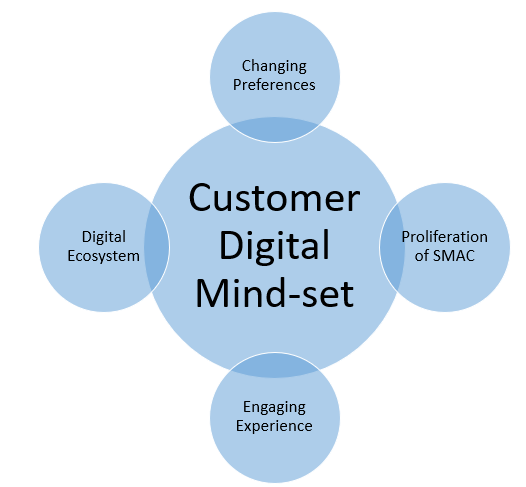In today’s changing business landscape, organisations are facing, now more than ever, a myriad of economic, regulatory, and intrinsic challenges.
Customers have more choice and their preferences are changing at an equally faster pace. The pandemic has accelerated the change in customer behaviour across all industry sectors.
Many businesses set out on a journey to focus on their customers without having a clear understanding of the mind-set of the customer.
Customer Mind-set
Today’s customers in most industries, are shifting steadfast towards a ‘Digital Mind-set’, which will soon become the norm.
This mind-set is characterised by demands for greater engagement experiences (omni channel) like those from the e-commerce and retail industry, higher price to value sensitivity, expectation of tailored products and agile service. It is also influenced by the proliferation of social media and the wider digital ecosystem. These characteristics all result in an increase of overall customer expectations from every organisation.
Changes in customer preferences and switching customer loyalty will require organisations to become truly customer centric. The demands for flexible, transparent, engaging, and personalised customer journeys and product or service portfolio, will take the centre stage. It’s a reality that some industries are behind others in being customer centric. For example, comparison websites help customers identify better deals and services for the customer, driving competition among service providers.
There is a new customer, with a ‘Digital Mind-set’, and many organisations are waking up to this reality.
The opportunities in ‘SMAC’ (Social, Mobile, Analytics, and Cloud) and digital are influencing customer expectation, behaviour, interaction and preferences. These are rapidly reshaping the way businesses operate. So, being customer centric is critical for the success of any firm.
Data-driven customer centricity
We believe there is no one size fits all approach and answer. Essential ingredients of success, however, would definitely include the following:
• a customer centric data strategy, supported by tailored data governance; and
• use of insights from customer analytics (machine learning) for strategic and competitive advantage.
Incorporating these two strategies would help embed a data driven approach across the entire customer lifecycle from targeting, acquisition, experience, and retention. This is fundamental to gain valuable insights and foresights into your customer.
Such insights should also feedback into various strategies that relate to the customer such as, but not limited to, marketing, sales, branding, product or service and customer care.
A key to success is to understand that it is a continuous process that will evolve and pay dividends for the business.
How can we help?
We bring extensive experience in addressing strategic and operational challenges through our Data and Automation services.
We can help define and implement a tailored data governance and strategy, and also provide customer analytics (using machine learning) as a fully managed service.
If you would like to know more about how we can help your business with Data Analytics please get in touch via the form below.
Enquire now


